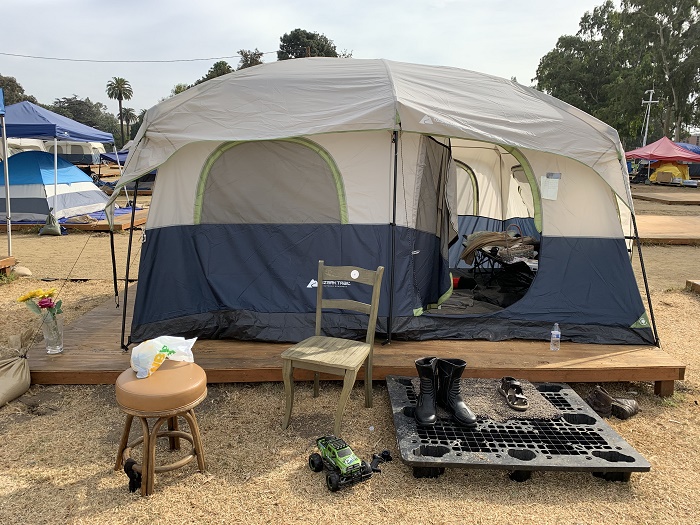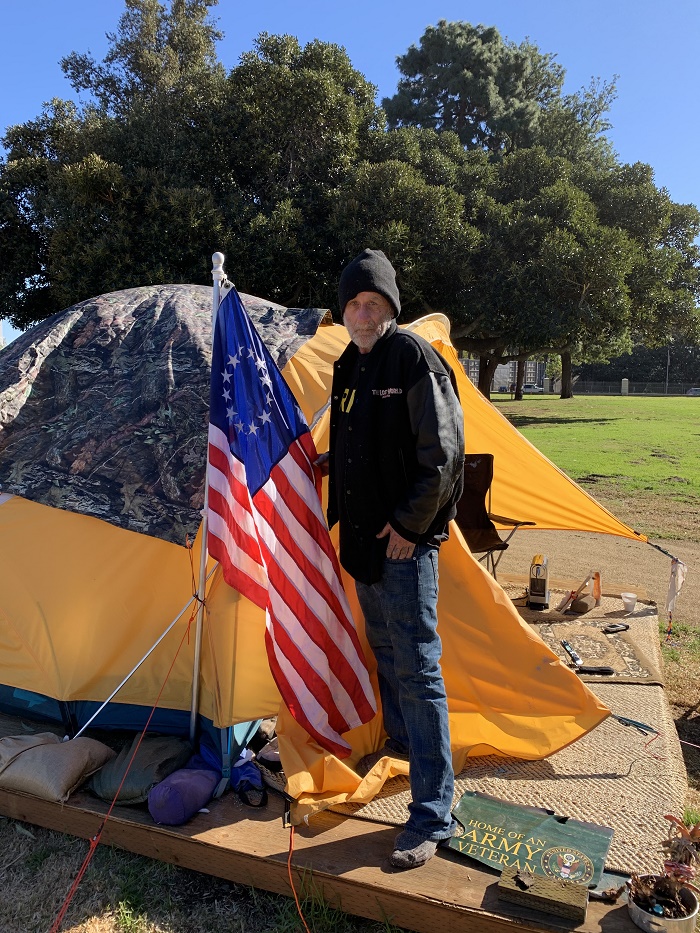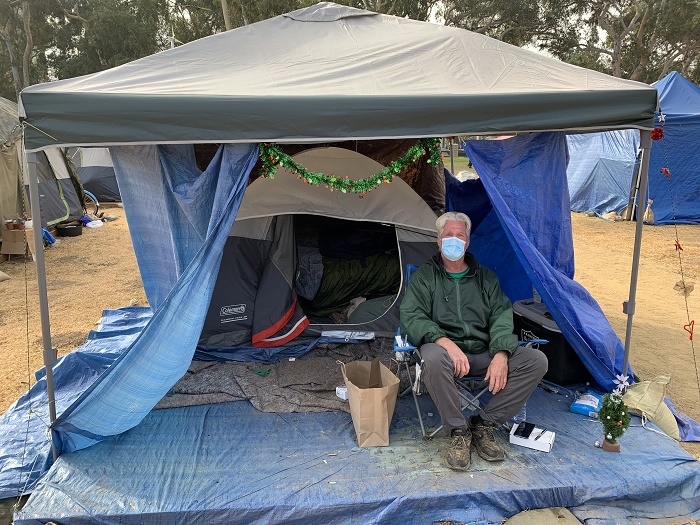 |
Homeless Veterans' Struggle During COVID-19 PandemicVeterans’ Perspectives highlights research conducted by HSR and/or QUERI investigators, showcasing the importance of research for Veterans – and the importance of Veterans for research. In the May-June 2024 Issue:
|
IntroductionThe COVID-19 pandemic rendered congregate shelter settings high risk, creating vulnerability for people experiencing homelessness. Residing outdoors as opposed to indoors was protective with respect to COVID-19 transmission. The pandemic arrived as Los Angeles County faced a housing crisis, with 64,000 people, including 4,000 Veterans, experiencing homelessness. Given the risks of COVID-19 transmission in indoor settings and fears that homeless individuals might contract and spread the virus, Los Angeles County instituted temporary emergency measures, including offering hotel and motel vouchers, and pausing forced removals of homeless encampments known as "sweeps." The West Los Angeles VA (WLAVA) took the unprecedented step of operating an outdoor tent encampment for unhoused Veterans on the health center campus. Concurrently, the moratorium on encampment sweeps enabled a group of Veterans sleeping just outside the WLAVA gates to develop a more permanent settlement. The StudyConducted by investigators with HSR’s Center for the Study of Healthcare Innovation, Implementation and Policy (CSHIIP) in Los Angeles, this longitudinal qualitative study examined the experiences of unhoused Veterans living in encampments on and just outside the WLAVA campus. Investigators highlight the distinct forms of care and community that existed in the two encampments: one run by VA and the other run by unhoused Veterans themselves. The first, an emergency COVID-19 mitigation intervention for unhoused Veterans called the “Care, Treatment, and Rehabilitation Service” (CTRS), was a “sanctioned encampment” on the grounds of the WLAVA. The second encampment consisted of as many as 50 Veterans camping in a row on the sidewalk abutting the WLAVA fence. This “unsanctioned” encampment became known as “Veterans Row.”
While more than 700 new units of housing at the West Los Angeles VA (WLAVA) were projected to be constructed by 2021, only 50 had been completed at the time of this writing. In the meantime, Veterans Row and VA’s creation of “Care, Treatment, and Rehabilitation Service” (CTRS) attempted to address the vulnerability to COVID-19 that was created by the housing gap.
“Care, Treatment, and Rehabilitation Service” (CTRS)Beginning as 25 tents in a VA parking lot in April 2020, CTRS infrastructure continuously improved, increasing capacity to 100 tents by September 2020. Though CTRS staffing varied, full-time staff included two social workers and two Veteran peer specialists. Supplemental/occasional staff included additional social workers, a preventative medicine physician, an occupational therapist, and primary care clinicians providing bimonthly onsite urgent care. Veterans had access to regular healthcare via virtual or in-person appointments within the campus medical center, which required a half-mile walk. Veterans RowVeterans Row had recognized leaders and a loose leadership council. Leaders facilitated partnerships with local restaurants, bakeries, and caterers to deliver daily meals. Veterans Row leaders created a census and tracking sheet of Veterans and their partners/family members residing in 45+ tents. They developed intake and orientation procedures for newly arrived Veterans. A list of duties and tasks was also assigned to residents (e.g., fire watch, street clean-up). Study Participants and InterviewsInvestigators conducted participant observation and interviews over 16 months in both Veteran encampments, including Veterans and VA personnel. Using physical distancing and masks, 65+ onsite participant-observation visits were made at least weekly from September 1, 2020, to October 1, 2021, with episodic visits into December 2021, yielding 450+ pages of fieldnotes. These data were integrated with semi-structured interviews with 21 unique Veterans who resided in CTRS and/or Veterans Row, and follow-up interviews with 7 Veterans, for a total of 28 Veteran interviews. Semi-structured interviews were also conducted with 11 CTRS personnel with 6 additional follow-up interviews for a total of 17 CTRS personnel interviews. Photos used with permission of Veterans pictured below. 


FindingsThe study revealed that Veterans conceptualized home not merely as physical shelter, but as encompassing a sense of inclusion and belonging. Veterans also called for addressing the root cause of their vulnerability to COVID-19: their homelessness. They made it clear that they felt abandoned by society. In leveraging their status as Veterans, they demanded to be seen, collectively, as a community who had served their nation and were deserving of a home on the VA campus. Further, their encampment was not just a site of pathology and risk, but a source of vitality, care, and support. Following are some of the important issues brought up by Veterans in this study. Since at least 2018, unhoused Veterans had been sleeping on the street just outside the western gates of the WLAVA, the site that would become Veterans Row. A former resident from Veterans Row described discovering the Veterans Row site two years before the pandemic. “I see all these people lined up and tents and people sleeping on the sidewalk. And so, I just walk over to see what this is and it’s Veterans! They say, ‘What’s up, man, what happened to you?’ And they’re laughing about it. They ask, ‘They’re not letting you in?’ And I say, ‘No, they told me to come back tomorrow.’ They say, ‘Well, we got you, this happens all the time.’ I mean it was common knowledge, and I was blown away. I thought, ‘What’s going on?’ . . . They gave me blankets. They gave me something to eat. They told me where everything was at.” By January 2021, many Veterans left CTRS for Veterans Row, either voluntarily or through involuntary discharge. Some Veterans “double-tented,” keeping a tent in each encampment to access the benefits of each site. CTRS began requiring residents to choose one encampment or the other. A discharged CTRS resident residing on Veterans Row situated the failure to care for unhoused Veterans, like him, within systemic societal failures. “The problem is that we fail time and time again, just as being derelict in our own duty to the person in front of us. Derelict to the idea that every person that is sitting in a bed that is a Veteran that needs help, receive help, and who has a voice should be heard.” Veterans Row accepted donations of larger 10’x14’ tents. The tents were organized next to each other, with an American flag affixed to the front of each tent. A Veteran explained why the appearance of large, orderly tents with the American flags was important. “We put flags on them to show that these were Veterans because there was . . . a lot of this public ignorance being built [by local residents]. And they’re posting on social media [that] they’re not Veterans, they don’t have benefits, they’re criminals. And we’re like, okay, we got the flags on them. No, these are Veterans.” One Veteran pointed out that their homelessness was often attributed to substance use, mental illness, and individual failings, with no consideration of the obstacles that some Veterans face. “We have PTSD, we lose it, then start drinking and doing drugs.” ImplicationsThe study concludes that housing interventions must consider how unhoused individuals become or fail to become integrated into various communities and foster therapeutic community connections. Thus, CTRS is a potential model for other medical centers and communities across the country to rapidly respond to the syndemics (co-occurring diseases due to harmful social conditions) of homelessness and COVID-19 – and for the many other comorbidities, medical and social, faced by the unhoused. The CTRS model works best when a sense of community is fostered and when encampment residents play a significant role in articulating the project’s mission. 
Ippolytos Kalofonos, MD, PhD, MPH (left) and Matthew McCoy, PhD, MFA, MA (right) Lisa Altman, MD; Sonya Gabrielian, MD, MPH; Ippolytos Kalofonos, MD, PhD, MPH; and Matthew McCoy, PhD, MFA, MA, are investigators with HSR’s Center for the Study of Healthcare Innovation, Implementation and Policy (CSHIIP). Study PublicationsMcCoy M, Kalofonos I, Altman L, et al. Improving a Sanctioned Homeless Encampment for Veterans During COVID-19 Through Multilevel Partnerships. Psychiatric Services. January 1, 2024;75(1):94–97. Kalofonos I, McCoy M, Altman L, et al. A Sanctioned Encampment as a Strategy for Increasing Homeless Veterans' Access to Housing and Healthcare During the COVID-19 Pandemic. Journal of General Internal Medicine. July 2023;38(S3):857–864. Lynch KA, McCoy M, and Gabrielian S. Veterans Finding Community and a "Home" Within an Emergency Housing Environment. Journal of Primary Care & Community Health. June 10, 2023; published online. |